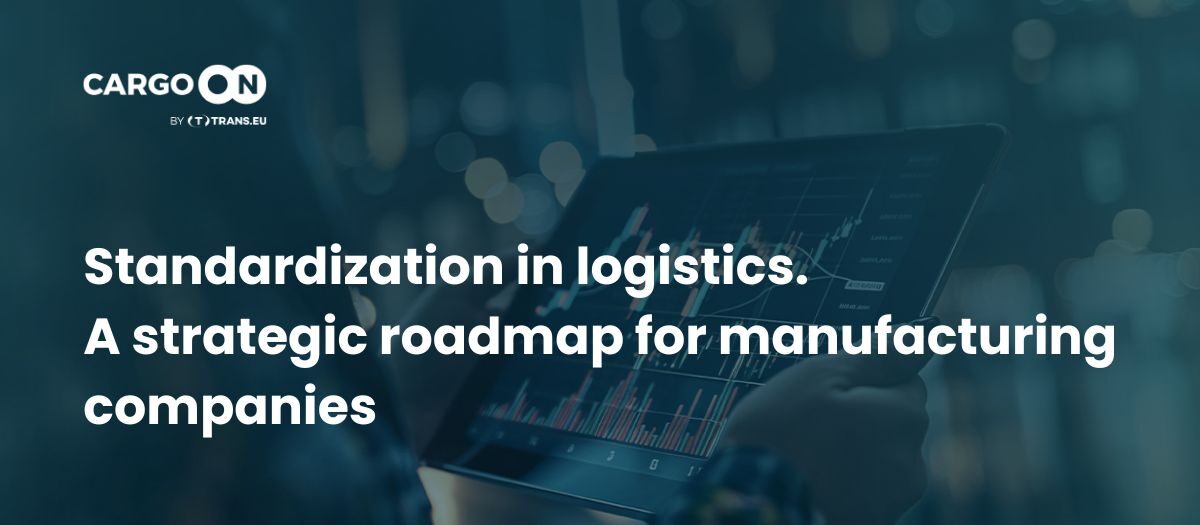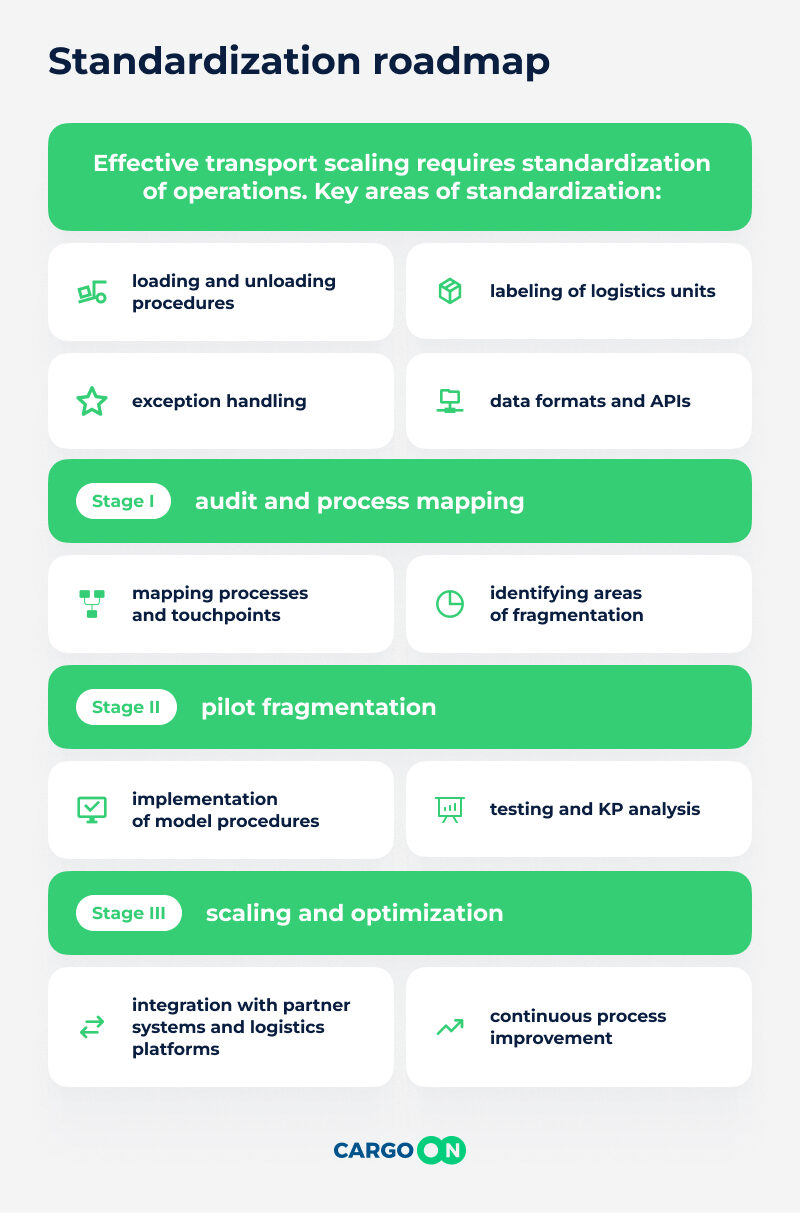Standardization in logistics. A strategic roadmap for manufacturing companies

Global supply chains are becoming increasingly complex, and growing regulatory requirements (ESG, emissions reporting, Data Act compliance) and cost pressures mean that lack of standardization is becoming a key barrier to scaling transport.
Effective scaling of transport in the global supply chain requires unification of operations. Key areas of standardization include:
- loading and unloading procedures,
- labeling of logistic units,
- exception handling,
- data formats and API.
Implementing comprehensive standardization in logistics requires a phased action strategy. Therefore, a standardization roadmap is needed to help manufacturing companies define a clear path from disparate processes to a fully integrated and scalable logistics system.
The roadmap below, based on industry practices and source research, outlines three main phases of digital transformation.
Stage I: Audit and process mapping
The first step is a thorough analysis of existing operations and systems. The audit aims to identify key touchpoints with supply chain partners and areas of greatest fragmentation and inconsistency.
Key questions the organization should answer:
- What standards and protocols are currently in use?
- Where are the biggest gaps or duplicate processes?
- Which operations generate the highest administrative costs or delays?
The analysis should also cover alternative costs resulting from a lack of standardization, such as the time-consuming nature of manual arrangements or the risk of data errors. It is recommended to develop a process map and classify it in accordance with industry best practices
Stage II: Pilot implementation
The second phase involves introducing standards in selected transport corridors or relations with the most important trading partners. The pilot will allow testing of the assumptions without incurring the full implementation costs.
Key activities:
- Selection of key logistics partners (e.g. 3PL, warehouse operators, carriers).
- Implementation of specific standards (e.g. GS1 labels, EDI, unified loading and unloading protocols).
- Implementation of TMS or logistics management platforms (e.g. CargoON).
- Establishing KPIs (lead time, unit cost, operational error rate) and monitoring results.
The pilot should be concluded with a comparative report that will serve as the basis for a decision on further scaling
Stage III: Scaling and optimization
The final phase involves extending the implemented standards to the entire logistics network and full integration with IT systems (TMS, ERP, WMS).
At this stage, the organization should:
- Provide training for all participants in the process.
- Implement tools for automating reporting and data exchange.
- Create a team for change management and process compliance audits.
The best results are achieved by companies that view standardization as a continuous process subject to regular evaluation and improvement. The organizational culture should support the adoption of new practices and their ongoing improvement.

Problem
Aluplast faced increasing pressure on punctuality, flexibility and transparency of deliveries, and traditional logistics models were no longer sufficient.
Activities
The company started the process of digitizing logistics by integrating transport planning with production and warehouses; implemented integrated CargoON tools for process management and based its strategy on data and automation.
Result
A coherent, integrated logistics model was created, allowing for better use of resources, cost reduction, real-time decision-making and long-term improvement of competitiveness.

Scaling logistics: trends for 2025-2030
1. Focus on sustainable development. Sustainable development is becoming a key driver of transformation in logistics. 70% of companies consider ESG factors in logistics decisions, and new EU regulations require detailed reporting of emissions from transport activities.
2. Automation and digitization. The logistics automation market will grow at a rate of 14.7% per year until 2030, driven by growing customer expectations. 83% of companies prioritize customer experience, which forces investment in real-time tracking systems and proactive communication about delivery status.
3. Platform integration. The integration of logistics platforms with TMS systems will enable real-time monitoring not only of the location of goods, but also of environmental parameters such as temperature and humidity. This is particularly important in cold chain logistics and the transport of pharmaceutical products.
Summary
Standardization in logistics is not an option today, but a necessity. It is a prerequisite for scaling transport in global supply chains. A roadmap of activities based on three stages – process audit, pilot implementations and scaling – allows companies to systematically move from fragmented practices to integrated operating models.
—
References
-
Qima, 2024 Global Supply Chain Landscape and Trends, 2024, https://www.qima.com/whitepaper/2024-global-sourcing-survey, access: 18.08.2025
-
ProcurementTactics, Supply Chain Statistics – 70 Key Figures of 2025, July 18, 2025, https://procurementtactics.com/supply-chain-statistics, access: 18.08.2025
-
Logistics and Warehousing, Standardization of Logistics Processes – Standards Increase Process Efficiency, August 21, 2024
-
Craig M., Optimizing Logistics Through Standardization, March 27, 2024, https://www.iienstitu.com/en/blog/optimizing-logistics-through-standardization, access: 18.08.2025
